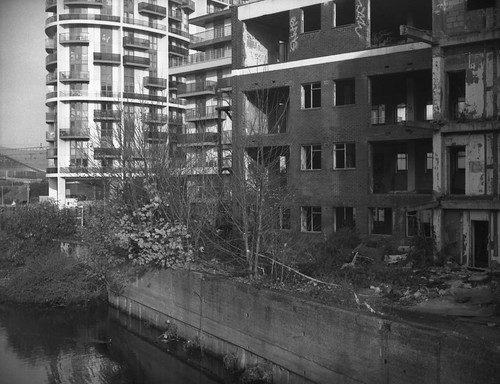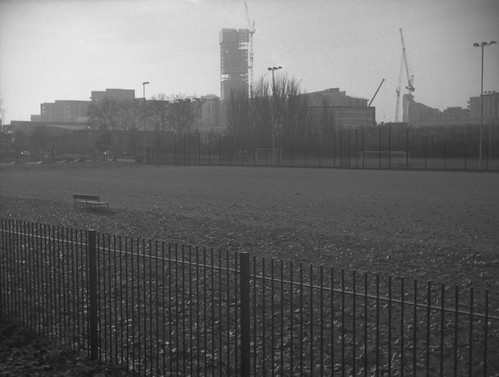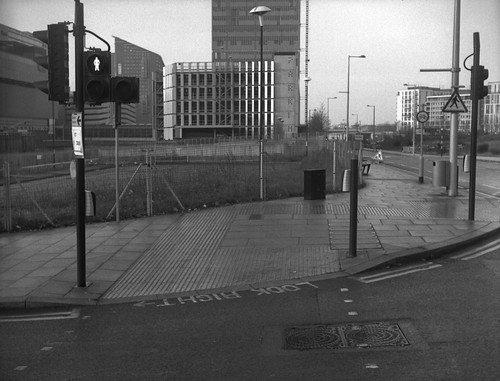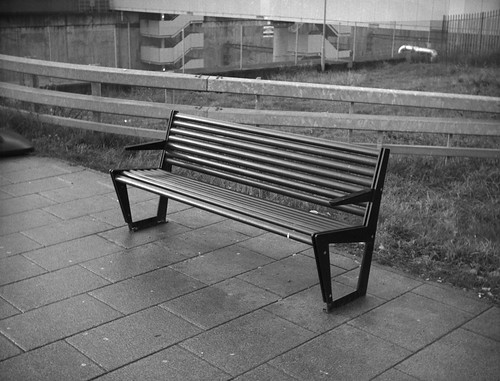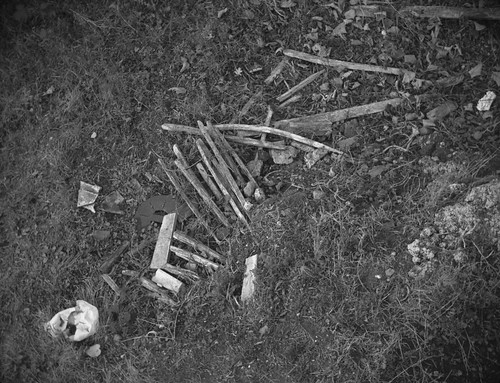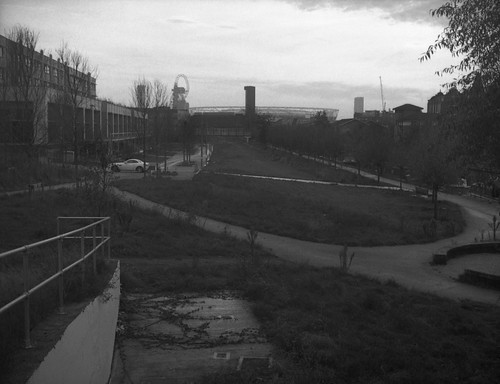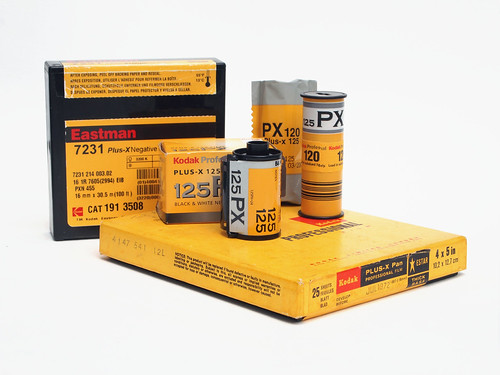 |
| Kodak/Eastman Plus-X in 16mm, 35mm, medium format and large format sheet film |
Eastman Plus-X was first introduced as a motion picture film in 1938, and shortly afterwards produced for still cameras in a number of different formats as
Kodak Plus-X. The emulsion number for Plus-X as a motion picture film was -231, with Kodak's standard prefix codes of 7 for 16mm, and 5 for 35mm. As a motion picture film, Plus-X was available in both negative and 16mm reversal stock. For still camera film, Kodak Plus-X had the code PX for many years (with PXP for medium format 'professional' films; PXE for Estar-based 70mm film; and PXT for thick-based sheet film), but it was reformulated around a decade ago, and was then designated 125PX. A comparison of development times shows these to be broadly similar, but changed in many cases by 15-30 seconds in many developers. Kodak's technial data sheet for the new version states:
"To reflect our enduring commitment to black-and-white photography, black-and-white film production will take place in an even more advanced film-coating facility. New technology applied to these superior, time-tested emulsions will result in slightly different processing times for the film family. But the same great films—those you've known and trusted for years—will still deliver the same breathtaking results."
One notable difference between the two versions was the new Plus-X was provided with development times for a three-stop push to EI 1000, while the earlier film was only recommended to be pushed no more than two stops; both films' data sheets stated that a one-stop push to 250 could be achieved without a change to development times. In my own tests below, I did not attempt more than one-stop push, given that I was working with discontinued film, although the 35mm motion picture film was manufactured in 2010, not old enough to really be concerned with increasing exposure to compensate for a loss of sensitivity with age; in some other formats, the Plus-X film I shot was much older.
In the
Kodak Reference Handbook from 1946 it is described under 'General Properties' for Roll Film and Film packs as being:
"High speed, fine grain, excellent gradation, wide exposure latitude. The speed and balanced color sensitivity make this film particularly suited to a wide range of outdoor conditions. It also has ample speed for well-lighted indoor subjects. The low graininess and high resolving power permit high quality enlargements many times the size of the original negative."
While for 35-mm and Bantam (
828) films:
"High speed and fine grain. For general miniature camera work this film should be used unless light conditions are very adverse or unless a very high degree of enlargement is intended."
Plus-X was originally rated 50 ASA, but at some point in the 1950s this was increased to 80 ASA (this
thread gives some information on Plus-X ratings). When speed ratings were changed for black and white films in 1960, Plus-X was rated at 160 ASA for a time, before gaining its 125 ISO rating, which it retained for nearly fifty years (Kodak's reference hand book implies the presence of the one-stop safety factor in the statement about Plus-X that, "When it is desired to reduce the exposure to a minimum, these values can be doubled with little danger of serious underexposure..." ). Additionally, the motion picture stock was recommended to be shot at a slower speed, 80 ISO in daylight and 50 under tungsten, which may just reflect the process of striking a positive from motion picture negative film, rather than a slower emulsion.
Eastman Plus-X was discontinued in 2010, with the notice for the still camera version announced the following year - although the production runs may have both stopped at the same time if the emulsion itself was the same. Incidentally, the Massive Dev Chart still has
Plus-X on its main chart, not on its discontinued/unlisted page. Kodak's rationalising of the film stocks it produces in recent years has meant the discontinuation of many of its classic films. This does leave Kodak without a medium-speed traditional emulsion film (Ilford's
FP4 Plus being the closest equivalent still available). Kodak suggests TMax 100 as a replacement for Plus-X; this film uses a modern T-grain emulsion. For most of the period that Kodak was manufacturing Plus-X, it also produced
Verichrome Pan, another still picture film with a traditional cubic emulsion at the same speed as Plus-X, only discontinued in 2002; Verichrome Pan does appear to have been available in some formats (126,
127) that Plus-X was not, but both were available in the most common formats - 35mm, medium format and sheet film.
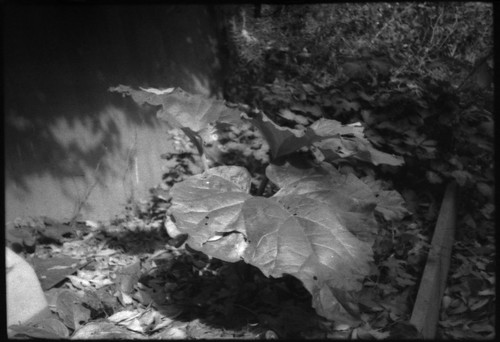 |
| Minolta 16QT with 16mm Kodak Plus-X, develop before date Sept 1971 |
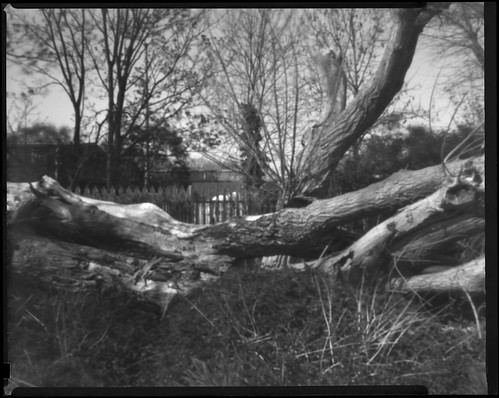 |
| MPP pinhole with 4x5 Kodak Plus-X, develop before date July 1972 |
I had first used Plus-X in a ready-loaded
Minolta-16 cartridge with a "develop before" date of September 1971. Around the same time, I also acquired a box of large format Plus-X from 1972 in a job lot, which I used for both this year's '
Expired Film Day' and on
Worldwide Pinhole Photography Day, which I rated at 25 to compensate for the loss of the film's sensitivity over the more than four decades since it was made. Apart from this loss of sensitivity, the quality of neither film appears to have been much compromised with age. Unintentionally, I had begun to use Plus-X after it had been discontinued almost by accident; I subsequently bought a 100-foot roll of 16mm film for 110 cartridge reloads and other subminiature formats, after using up two rolls of Kodak WL Surveillance film, and finding
the Photo Instrumentation film rather grainy. As Plus-X had been a motion picture stock, I wanted to use it for a separate project that I have been pursuing,
looking at film locations; given how recently it has been discontinued, I found it relatively easy to find across Plus-X in 35mm and 120 online.
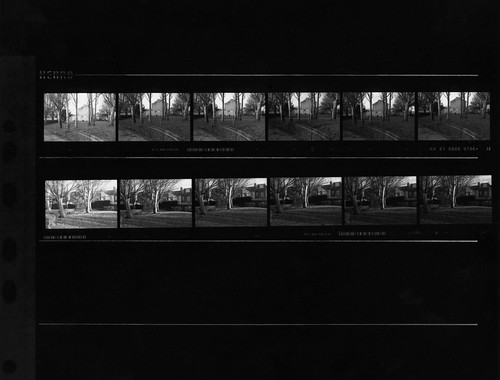 |
| 35mm Kodak Plus-X motion picture film latitude test |
To test the film in 35mm, I bought some bulk motion picture Eastman Plus-X 5231. According to
Kodak's guide, the date of manufacture for the 35mm Plus-X that I bought is 2010, which would mean that it was in the very last batches made before discontinuation that year, based on the edge code once developed. I tested the latitude of the film, as shown in the contact sheet above. For the first row, the film was exposed at indexes of 40, 80, 100, 125, 160, and 200. However, with the light changing due to quick-moving thin clouds, shooting manually, I couldn't be sure that I had a perfect set of exposures, so I repeated the latitude test a couple of days later. For the second row I used the same set of exposure indices, but the lighting on the day was more consistent. The film was shot with a
Canon A-1 SLR and developed in Ilfotec LC29 at a dilution of 1+19 for 6 minutes at 20ºC. Both tests showed good latitude with a moderate amount of contrast over the fairly short range of exposures, and a relatively clear base, presumably being good for motion picture use, as well as possibly useful when scanning. Part of the reason for choosing these speeds was an attempt to be precise over whether any adjustments for age needed to be made, given that the motion picture stock is recommended to be shot at a slower speed (80 ISO in daylight) than the still camera version (125 ISO), which may just reflect the process of striking a positive from motion picture negative film.
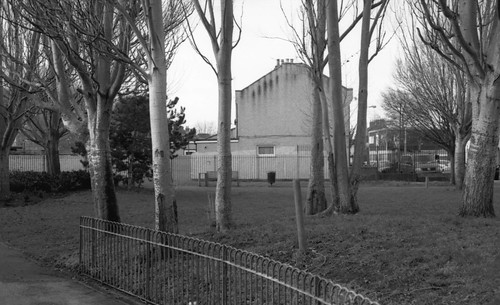 |
| Canon A-1 with Plus-X rated 40 |
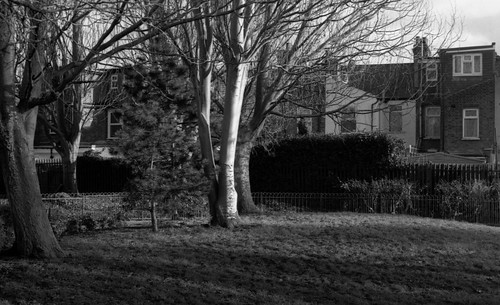 |
| Canon A-1 with Plus-X rated 200 |
Although I used a narrower range for the test than for other films I've tested, the results appeared to show the Plus-X has fairly good latitude; the two examples above from either end of the scale of exposures I used are both quite acceptable, in the lower image it might have been possible to pull more detail from the shadow areas. Other than the Plus-X from the 1970s, the last batches of 35mm motion picture stock and the medium format from the past decade were either shot at box speed, or generally rated at 100 rather than 125. I haven't tested Plus-X for push processing apart from one roll at 200, pushing one stop (or 2/3 of a stop) in Ilfotec DD-X. With the lighting conditions when the film was shot, the results were fairly high in contrast, I also shot the film with a yellow filter, which helped provide detail in the sky. As Plus-X has only been discontinued within the last decade, there's still a lot of the film around in different formats, although since I bought my last bulk roll, I have seen that prices have increased online. Perhaps Kodak Plus-X isn't significantly different from Ilford's FP4 Plus to make shooting it today anything other than a historical curiosity - I had never used the film before it was discontinued - although as a motion picture stock, it's a fortunate curiosity, appropriate enough to the ongoing project shooting film locations.
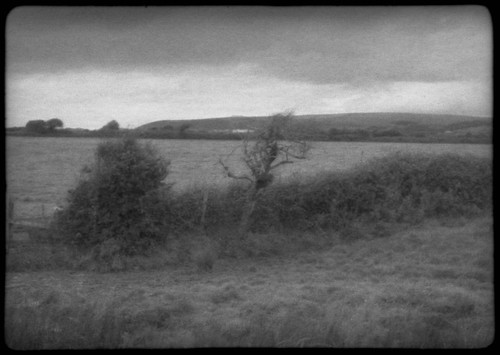 |
| Mamiya-16 Automatic with 16mm Eastman Plus-X |
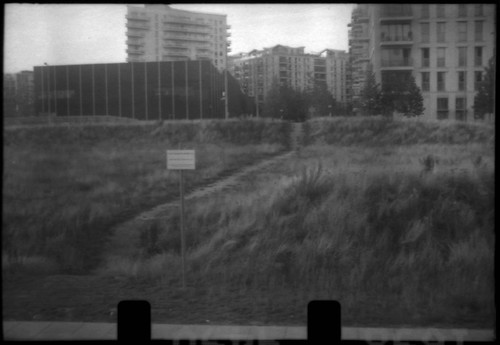 |
| Pentax Auto 110 with 16mm Eastman Plus-X |
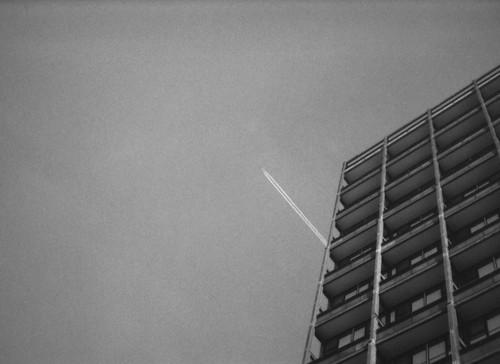 |
| Agat 18K (35mm half frame) with Kodak Plus-X motion picture film, developed in Ilfotec LC29 |
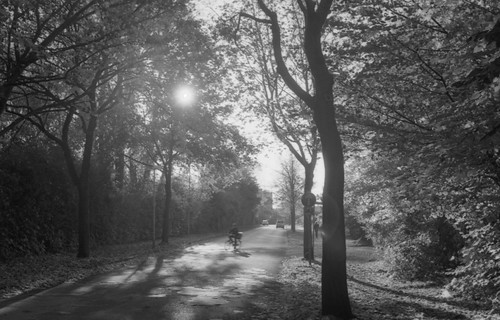 |
| Kodak Retina IIa (35mm) with Kodak Plus-X motion picture film, developed in Ilfotec LC29 |
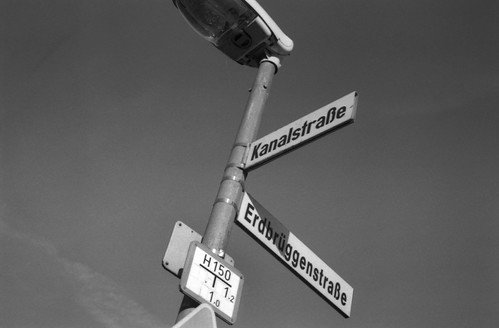 |
| Kodak Retina IIa (35mm) with Kodak Plus-X, rated 200, push processed in Ilfotec DD-X |
 |
| Kiev-4 rangefinder (35mm) with Kodak Plus-X motion picture film, developed in Ilfotec LC29 |
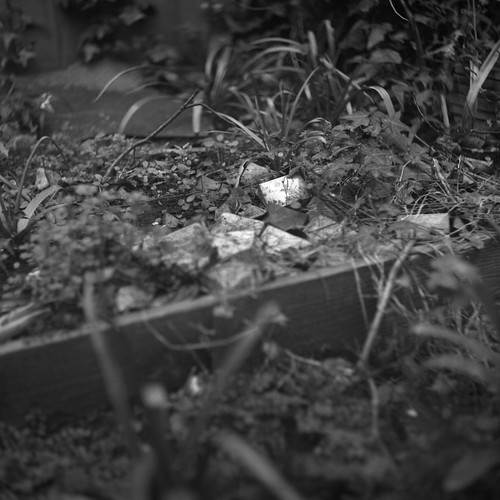 |
| Ikoflex Ic (medium format 6x6) with Plus-X, develop before date of 03/2006, developed in R09 One Shot |
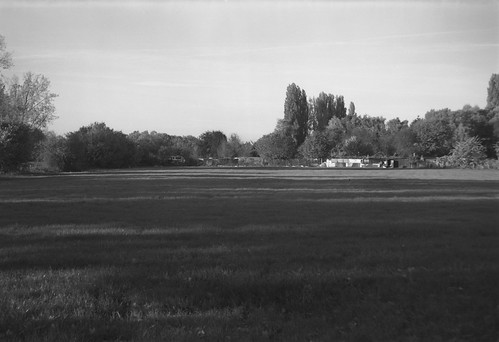 |
| Zodel Baldalux (medium format 6x9) with Plus-X, develop before date 02/2007, developed in Ilfotec DD-X |
Sources/further reading:
Kodak's history of motion picture film stocks
Plus-X Pan (PXP) tech sheet on 125px.com
Plus X (PX125) tech sheet on 125px.com
Kodak Reference Handbook 1946
http://silverbased.org/plus-x-kodak-woes/
https://blog.jimgrey.net/2014/06/25/shooting-kodak-plus-x-pan/
http://adambhalalough.com/post/572281627/thoughts-on-kodak-discontinuing-plus-x-bw-film





